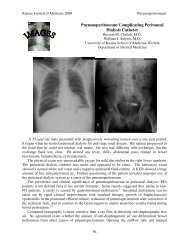The Silence of Neurosyphilis - Archie Home
The Silence of Neurosyphilis - Archie Home
The Silence of Neurosyphilis - Archie Home
You also want an ePaper? Increase the reach of your titles
YUMPU automatically turns print PDFs into web optimized ePapers that Google loves.
Kansas Journal <strong>of</strong> Medicine 2011 <strong>The</strong> <strong>Silence</strong> <strong>of</strong> <strong>Neurosyphilis</strong><br />
impairment <strong>of</strong> verbal comprehension. He<br />
manifested perseveration <strong>of</strong> verbal<br />
responses, anomia, dysgraphia, and he was<br />
unable to repeat sentences.<br />
His pupils were equal, round, and<br />
reactive to light. Extraocular movements<br />
demonstrated an increase in horizontal<br />
nystagmus bilaterally and a few beats <strong>of</strong><br />
vertical nystagmus with upward gaze.<br />
Visual fields were full and visual acuity was<br />
20/100 O.S., 20/100 +1 O.D., without<br />
glasses using a pocket card. Facial sensation<br />
was normal with no facial weakness.<br />
Hearing for whispered numbers was normal.<br />
His tongue was at midline and no dysarthria<br />
was noted.<br />
Strength in both upper and lower<br />
extremities and rapid alternating and fine<br />
motor movements were normal. He<br />
manifested mild postural tremor and<br />
intention tremor with finger-to-nose testing.<br />
<strong>The</strong> sensory examination was unreliable.<br />
Deep tendon reflexes were only trace in the<br />
upper extremities and at the knees but<br />
symmetrical. Plantar responses were<br />
equivocal bilaterally. His feet were swollen,<br />
firm, non-tender, and non-erythematous,<br />
with slight black discoloration <strong>of</strong> the pedal<br />
digits (Figure 2). <strong>The</strong> swelling extended<br />
above the ankles bilaterally.<br />
Figure 2. Gangrene <strong>of</strong> the right foot.<br />
112<br />
Laboratory results (Table 1)<br />
demonstrated an elevated white blood cell<br />
count, renal insufficiency, elevated creatine<br />
phosphokinase (CPK) consistent with acute<br />
rhabdomyolysis, and positive serology for<br />
syphilis. Emphysematous changes were<br />
noted on chest x-ray.<br />
<strong>The</strong> patient developed a fever to 103.3 o F<br />
and became tachycardic and hypotensive,<br />
fulfilling Systemic Inflammatory Response<br />
Syndrome criteria. 2 <strong>The</strong> patient was<br />
transferred to the ICU and treated with IV<br />
fluids, vasopressors, and antibiotics after<br />
appropriate cultures were obtained. <strong>The</strong><br />
CPK recovered with intravenous fluids and<br />
bicarbonate. An arterial ultrasound <strong>of</strong> the<br />
lower extremities showed absence <strong>of</strong> pedal<br />
pulses bilaterally. An orthopedic surgeon<br />
recommended pedal digit amputation<br />
secondary to wet gangrene as a complication<br />
<strong>of</strong> frost bite.<br />
A magnetic resonance image (MRI) <strong>of</strong><br />
the brain (Figure 3) displayed a subacute<br />
infarct in the distribution <strong>of</strong> the posterior<br />
division <strong>of</strong> the left middle cerebral artery. A<br />
magnetic resonance angiogram (MRA)<br />
showed mild distal carotid arterial<br />
atherosclerosis without other angiographic<br />
abnormality (Figure 4). Trans-esophageal<br />
echocardiogram and carotid ultrasound were<br />
unremarkable.<br />
<strong>The</strong> patient was diagnosed with a stroke<br />
secondary to neurosyphilis-induced<br />
vasculitis and possible tabes dorsalis to<br />
explain the mostly painless nature <strong>of</strong> the wet<br />
gangrene <strong>of</strong> the toes. <strong>The</strong>rapy was initiated<br />
with penicillin G continuous infusion for<br />
three weeks with lev<strong>of</strong>loxacin and<br />
metronidazole for the gangrene. <strong>The</strong> patient<br />
underwent bilateral pedal digit amputation<br />
with debridement and skin graft and was<br />
placed in a nursing home for physical<br />
rehabilitation. One-month after discharge,<br />
patient was readmitted for surgical<br />
debridement <strong>of</strong> his amputation. He had no<br />
improvement <strong>of</strong> his cognitive status.











